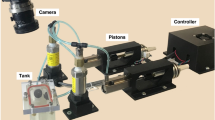Abstract
Lung parenchyma is normally considered to be isotropic, that is, its properties do not depend upon specific preferential directions. The assumption of isotropy is important for both modeling of lung mechanical properties and quantitative histologic measurements. This assumption, however, has not been previously examined at the microscopic level, in part because of the difficulty in large lungs of obtaining sufficient numbers of small samples of tissue while maintaining the spatial orientation. In the mouse, however, this difficulty is minimized. We evaluated the parenchymal isotropy in mouse lungs by quantifying the mean airspace chord lengths (Lm) from high-resolution histology of complete sections surrounded by an intact continuous visceral pleural membrane. We partitioned this lung into 5 isolated regions, defined by the distance from the visceral pleura. To further evaluate the isotropy, we also measured Lm in two orthogonal spatial directions with respect to the section orientation, and varied the sample line spacing from 3 to 280 μm. Results show a striking degree of parenchymal anisotropy in normal mouse lungs. The Lm was significantly greater when grid lines were parallel to the ventral–dorsal axis of the tissue. In addition the Lm was significantly smaller within 300 μm of the visceral pleura. Whether this anisotropy results from intrinsic structural factors or from nonuniform shrinkage during conventional tissue processing is uncertain, but it should be considered when interpreting quantitative morphometric measurements made in the mouse lung.








Similar content being viewed by others
References
Allen G. B., Pavone L. A., DiRocco J. D., Bates J. H., Nieman G. F. Pulmonary impedance and alveolar instability during injurious ventilation in rats. J. Appl. Physiol. 99:723–730, 2005. doi:10.1152/japplphysiol.01339.2004
Campbell H., Tomkeieff S. I. Calculation of the internal surface of a lung. Nature 170: 117, 1952. doi:10.1038/170117a0
Cruz-Orive L. M., Weibel E. R. Sampling designs for stereology. J. Microsc. 122: 235–257, 1981
Dobrin P. B. Effect of histologic preparation on the cross-sectional area of arterial rings. J. Surg. Res. 61: 413–415, 1996. doi:10.1006/jsre.1996.0138
Gundersen H. J. The smooth fractionator. J. Microsc. 207: 191–210, 2002. doi:10.1046/j.1365–2818.2002.01054.x
Gundersen H. J., Jensen E. B., Kieu K., Nielsen J. The efficiency of systematic sampling in stereology-reconsidered. J. Microsc. 193: 199–211, 1999. doi:10.1046/j.1365-2818.1999.00457.x
Halbower A. C., Mason R. J., Abman S. H., Tuder R. M. Agarose infiltration improves morphology of cryostat sections of lung. Lab. Invest. 71: 149–153, 1994
Huang Y. I., Mitzner W. Distribution analysis of alveolar size by digital imaging. J. Comput.-Assist. Microsc. 1: 397–409, 1989
Hyde D. M., Blozis S. A., Avdalovic M. V., Putney L. F., Dettorre R., Quesenberry N. J., Singh P., Tyler N. K. Alveoli increase in number but not size from birth to adulthood in rhesus monkeys. Am. J. Physiol. Lung. Cell. Mol. Physiol. 293: L570–L579, 2007. doi:10.1152/ajplung.00467.2006
Lum H., Huang I., Mitzner W. Morphologic evidence for alveolar recruitment during inflation at high transpulmonary pressure. J. Appl. Physiol. 68: 2280–2286, 1990
Lum H., Mitzner W. Effects of 10% formalin fixation on fixed lung volume and lung tissue shrinkage. Am. Rev. Respir. Dis. 132: 1078–1083, 1985
Mattfeldt T., Mall G., Gharehbaghi H., Moller P. Estimation of surface area and length with the orientator. J. Microsc. 159: 301–317, 1990
Mead J., Takishima T., Leith D. Stress distribution in lungs: a model of pulmonary elasticity. J. Appl. Physiol. 28: 596–608, 1970
Miki H., Butler J. P., Rogers R. A., Lehr J. L. Geometric hysteresis in pulmonary surface-to-volume ratio during tidal breathing. J. Appl. Physiol. 75: 1630–1636, 1993
Nyengaard J. R., Gundersen H. J. The isector: a simple and direct method for generating isotropic, uniform random sections from small specimens. J. Microsc. 165: 427–431, 1992
Oldmixon E. H., Butler J. P., Hoppin F. G. Jr. Dihedral angles between alveolar septa. J. Appl. Physiol. 64: 299–307, 1988
Parameswaran, H., Majumdar, A., Ito, S., Alencar, A. M., B. Suki. Quantitative characterization of airspace enlargement in emphysema. J. Appl. Physiol. 100: 186–193, 2006
Perlman C. E., Bhattacharya J. Alveolar expansion imaged by optical sectioning microscopy. J. Appl. Physiol. 103: 1037–1044, 2007. doi:10.1152/japplphysiol.00160.2007
Scherle W. A simple method for volumetry of organs in quantitative stereology. Mikroskopie 26: 57–60, 1970
Schiller H. J., McCann U. G. 2nd, Carney D. E., Gatto L. A., Steinberg J. M., Nieman G. F. Altered alveolar mechanics in the acutely injured lung. Crit. Care Med. 29: 1049–1055, 2001. doi:10.1097/00003246-200105000-00036
Shannon, C. E. Communication in the presence of noise. Institute of Radio Engineers (Reprinted in Proceedings of the IEEE, 86, 447–457, 1998) 37:10–21, 1949.
Soutiere S. E., Tankersley C. G., Mitzner W. Differences in alveolar size in inbred mouse strains. Respir. Physiol. Neurobiol. 140: 283–291, 2004. doi:10.1016/j.resp.2004.02.003
Weibel E. R. Morphometry of the Human Lung. New York: Academic Press, 1963
Weibel E. R., Hsia C. C., Ochs M. How much is there really? Why stereology is essential in lung morphometry. J. Appl. Physiol. 102: 459–467, 2007. doi:10.1152/japplphysiol.00808.2006
Author information
Authors and Affiliations
Corresponding author
Appendix: Measurement of Lm with ImageJ
Appendix: Measurement of Lm with ImageJ
This is the plugin macro for ImageJ that will logically combine an image called “Section 2U.tif” on the desktop, with an image called “Lm analysis grid.tif” consisting of a grid of parallel lines located in the Documents folder. The data window will list the length of all the chords that run through open space. Chords that hit the edge of the camera rectangle are not counted.
-
saveAs(“Tiff”, “/Users/physiologydivision/Desktop/ Section 2u.tif “);
-
run(“Set Scale...”, “distance=0.680 known=1 pixel=1 unit=μm global”);
-
open(“/Documents/Lm analysis grid.tif “);
-
run(“Threshold”);
-
run(“Invert”);
-
imageCalculator(“AND create”, “Section 2u.tif”,” Lm analysis grid.tif “);
-
//run(“Image Calculator...”, “image1= Section 2U.tif operation=AND image2=[ Lm analysis grid.tif.tif] create”);
-
run(“Threshold”, “stack”);
-
run(“Set Measurements...”, “area standard perimeter feret’s redirect=None decimal=2”);
-
run(“Analyze Particles...”, “minimum=1 maximum=999 bins=20 show=Outlines display exclude size clear record stack”);
Rights and permissions
About this article
Cite this article
Mitzner, W., Fallica, J. & Bishai, J. Anisotropic Nature of Mouse Lung Parenchyma. Ann Biomed Eng 36, 2111–2120 (2008). https://doi.org/10.1007/s10439-008-9538-4
Received:
Accepted:
Published:
Issue Date:
DOI: https://doi.org/10.1007/s10439-008-9538-4




